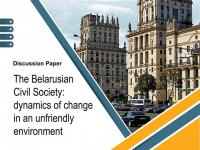We present a Discussion paper of dynamics of changes in the Belarusian civil society in 2015-2017.
Belarusan society’s solidarity potential

We present a research results report of the Belarusan society’s solidarity potential. It is a continuation and development of the research Belarusan organized civil society’s solidarity potential (NGO sector, “third sector”) carried out in 2014.
This research was carried out by the Center for European Transformation and the Belarusian Institute for Strategic Studies and initiated by Belarusan human rights defending organizations: Barys Zvozskau Belarusian Human Rights House, Human Rights Center “Viasna”, Belarusian Helsinki Committee, Legal Transformation Center (Lawtrend), Committee for the Protection of the Repressed “Salidarnasts”, Belarusian Association of Journalists, and Assembly of Democratic NGOs in Belarus.
* * *
During the last few years, in Belarusan society’s public and political life, we can observe a decrease in citizens’ ability to organize joint effective political and public actions, to demonstrate publicly and actively their own position, and to defend common interests. In spite of the increasing number of petitions, public statements, and signatures gathering campaigns, we can see not only the absence of any influence of these tools on the life of the country, but their weak mobilization potential as well. More often than not, they just remain a way of revealing one’s own personal position and do not result in either a launch of further joint actions, or a change of a situation. The general tendencies of the public-political life give evidence of not simply a decrease in political activity, but also of a change of the structure of social connections and relations, which solidarity activity can be built on. Thus, since 2006, after the reduction of the mass character of support rendered to the traditional forms of displaying civic and social activity (rallies, protest actions), there appeared several “new” forms, e.g. silent protest actions, campaigns to collect aid for detainees and political prisoners, all possible kinds of flash mobs, etc. These flares of one-time actions demonstrate a potential possibility of such behavior, but every time any attempts to repeat this or that successful practice and to disseminate it meet with failure. Explanatory versions and concepts that appeal to the “new media” or “new majority” are wide open to both practical and empirical criticism. At the same time, the practice of work of public associations and civil initiatives which activities are aimed at changing Belarusan society requires answers to the question — What can one count on and what can one lean on when it comes to mutual support and solidarity displays?
What can unite and mobilize the activity of Belarusan citizens (for the sake of what are they ready to get united and to act extensively)? Who (what social groups, strata, communities) is the most capable of demonstrating solidarity? In search of answers to these questions, we have to study the fabric of public relations as a material and a basis of these or those solidarity actions.
This research does not assign a task to conceptually study the question of solidarity, but to analyze empirical material.
At the first stage, which was implemented in September 2013 — June 2014, the object of our research was not all Belarusan society, but only the part that can be considered the nucleus of solidarity displays, which can set the beginning of social movements, i.e. organized civil society (the NGOs sector, the “third sector”).
At the second stage (January-October 2015), we studied Belarusan society as a whole, correcting only some details in the toolkit of our research, taking into account the change of the object of research. The preservation of the conceptual bases and the research technique allows us to analyze the solidarity potential in Belarusan society and to carry out a comparative analysis of the results of these two stages.
The goal of this research is to evaluate and to substantially interpret the potential of public-political solidarity in Belarusan society. We understand solidarity as a manifestation of connections and relations between people, which is expressed in joint informal and emergent actions (support, assistance, joining) of a public (non-production) character that lead to the defense of common interests and achievement of overall objectives.
The important characteristic of solidarity actions is their situational (one-time) character, i.e. solidarity appears and can be pinpointed in its concrete displays, but it does not exist as a permanent kind of employment and activity, or as a constant characteristic of this or that community, group, society as a whole. In this regard, the subject of our research is the solidarity potential. We understand the solidarity potential as such a quality of connections and relations between people, which allow them to carry out solidarity actions in the public-political sphere and which are the basis for solidarity displays.
The preconditions and bases for solidarity displays (the solidarity potential) will be considered at several levels:
1. Level of subjective semantic spaces. Subjective semantic spaces are such a system of categories of individual consciousness with the help of which various objects and notions are evaluated and classified. This evaluation is based on affective, extramental guidelines. The similarity of subjective spaces and of the arrangement of various significant “objects” (values, symbols, persons, etc.) in these spaces attests indirectly to the similarity of possible reactions to a situation, to the potential of understanding and supporting each other with regard to public-political events and problems that have to do with these “objects”, and, accordingly, to the predisposition to demonstrate solidarity.
2. Level of self-consciousness and social relations (in particular, social identification and trust in various groups, subjects, and institutions). The realization of the belonging to a certain circle can be a basis for actions of supporting the people who are thought to belong to the same circle and to have the same interests, purposes, values, points of view, etc. — “we are workers”, “we are intelligentzia”, “we are citizens”, “we are democrats”, etc. The substantial bases of this belonging can act as signs or objects of solidarity. Trust characterizes a positive predisposition to act and to expect solidarity manifestations with regard to oneself (Who can I rely on? Whose support can I count on?). The type of groups which a person identifies him/herself with and which seems credible to him/her (family or a professional community, neighbors or representatives of local authorities) provides some additional information on the solidarity potential and its contents. A person’s adherence to and trust in non-formalized groups and communities characterizes his/her readiness to independently define situations and purposes of solidarity actions. The prevalence of trust in formal institutions and abstract social communities characterizes society’s high degree of fragmentation and its unpreparedness to carry out individual actions aimed at protecting and advancing its interests and values.
3. Level of practice, experience, and behavioral patterns. The available experience of implementing solidarity actions not only provides the grounds to extrapolate similar actions in the future, but also characterizes a certain way of life and the forms of forming social connections and relations. Today, researchers address to the strengthening of the role and meaning of communicatory connections and relations, in comparison with other forms of social coalescence. Therefore, the structure of communication of organized civil society’s representatives does matter. The development of informational and communicational technologies considerably enhances the factor of the intensity of communication in regard to the collective social action. Forms, places, and contents of communication create certain behavioral patterns which characterize the potential of solidarity actions.
Within this framework, we set the following research tasks:
1. to evaluate and to substantially describe Belarusan society’s solidarity potential:
- to define the specificity of social identification and trust as bases for solidarity actions;
- to evaluate a possibility of demonstrating solidarity on the basis of the similarity (difference) of the Belarusans’ semantic fields;
- to mark out characteristics of Belarusan citizens’ communicatory behavior and to designate the specificity of the experience of solidarity actions;
2. to determine the possibilities of stimulating and mobilizing the solidarity potential:
- the consolidating/disintegrating force of various objects of public-political life (events, persons, positions, values);
- the potential of leaning on opinion leaders, public and political persons.
The information was gathered with the help of a questionnaire.
The research was implemented in January-October 2015 (the field stage — in May-June 2015).
The full version of research report is available in Russian.
Download document 
See also: Research into Belarusan organized civil society’s solidarity potential (2014)
About the authors:
Tatsiana Vadalazhskaya is a senior analyst of the Center for European Transformation, PhD in sociology. She graduated from the Sociology Department of Belarusan State University. Since 1996, she has been working in the field of humanitarian research — at first, as a research scientist in the Institute of Sociology of the National Academy of Sciences of Belarus, then — as an expert of the analytical group of the Humanitarian Techniques Agency. Her research interests include humanitarian and social studies methodology, national and civic identity, local communities development, civil society, cultured politics, and the policy in the sphere of culture.
Aksana Shelest is a senior analyst of the Center for European Transformation, PhD in sociology. She graduated from the Sociology Department of Belarusan State University and did her postgraduate studies in the Institute of Sociology of the National Academy of Sciences of Belarus, where she later worked as the head of the sector of operational research methods and practices, as an academic secretary, and as the head of the department of sociological studies techniques. She is an expert of the analytical group of the Humanitarian Techniques Agency. Her research interests include religiousness transformation, social communication and communication techniques, sociological research methodology and methods.
Andrei Yahorau is the director of the Center for European Transformation, master of political science. He graduated from the Politology Department of Belarusan State University and received his master’s degree in political science at the same university. Since 2001, he has been working in the field of political research. Since 2005, he is an expert and the head of the analytical group of the Humanitarian Techniques Agency. His research interests include post-Soviet territory transformation, civil society, political transformations in Belarus and the Eastern Partnership region, and European studies.
Alena Artsiomenka is an analyst of the Belarusian Institute for Strategic Studies, bachelor of social and political philosophy (EHU), expert in information and communication (BSU), master of sociology (BSU). Her research interests include public opinion, social contracts (well-being of the population, rating of trust in authorities), geopolitical orientations of the population, EU technical aid, human capital (education, labor market), migration, demography, and the influence of the mass media on the audience.
The data mathematical analysis is carried out by Nikolay N. Leonov, candidate of physico-mathematical sciences.
Others
-
Belarusan human rights defenders’ view on human rights activity and questions of cooperation between Belarusan human rights organizations
We present a research results report of Belarusan human rights organizations sector.
-
Social base of transformation programs in Belarus
We present a sociological research report (abridged version) of social base of transformation programs in Belarus.
-
Potential and opportunities for launching in Belarus the mechanisms to enjoyment of all human rights by persons with disabilities
We present a research results report (abridged version) of potential and opportunities for launching in Belarusan regions the mechanisms of local planning to promote, protect and ensure the full and equal enjoyment of all human rights and fundamental freedoms by all persons with disabilities.
-
Capacity of youth non-governmental organizations and Initiative groups for cooperation in addressing common objectives
The Centre for European Transformation, commissioned by the Office for European Expertise and Communication, in April-June 2015 was carried out a study to assess the interaction potential of Belarusan youth NGOs in the solution of common tasks.








Comments
From farewell to a new Eastern policy and towards a new development
Poland and Germany were both initiators and drivers of a New Eastern policy linked to the Eastern neighborhood and Russia/Soviet Union.